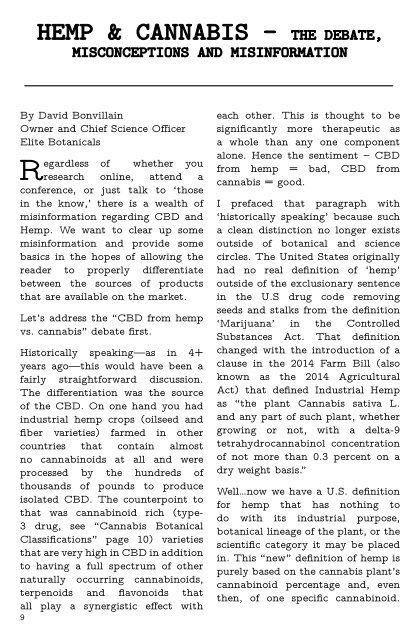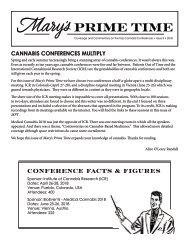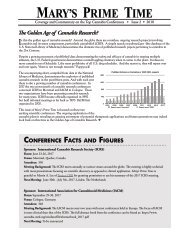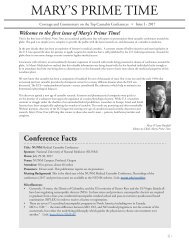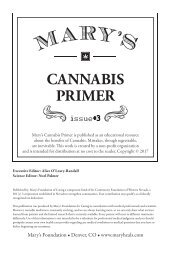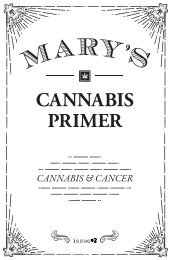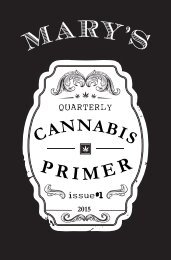#5: It's a Hemp Thing
Mary's Cannabis Primer is published as a resource for national and international education about the benefits of Cannabis. This issue is dedicated to Hemp.
Mary's Cannabis Primer is published as a resource for national and international education about the benefits of Cannabis. This issue is dedicated to Hemp.
Create successful ePaper yourself
Turn your PDF publications into a flip-book with our unique Google optimized e-Paper software.
HEMP & CANNABIS – THE DEBATE,<br />
MISCONCEPTIONS AND MISINFORMATION<br />
By David Bonvillain<br />
Owner and Chief Science Officer<br />
Elite Botanicals<br />
Regardless of whether you<br />
research online, attend a<br />
conference, or just talk to ‘those<br />
in the know,’ there is a wealth of<br />
misinformation regarding CBD and<br />
<strong>Hemp</strong>. We want to clear up some<br />
misinformation and provide some<br />
basics in the hopes of allowing the<br />
reader to properly differentiate<br />
between the sources of products<br />
that are available on the market.<br />
Let’s address the “CBD from hemp<br />
vs. cannabis” debate first.<br />
Historically speaking—as in 4+<br />
years ago—this would have been a<br />
fairly straightforward discussion.<br />
The differentiation was the source<br />
of the CBD. On one hand you had<br />
industrial hemp crops (oilseed and<br />
fiber varieties) farmed in other<br />
countries that contain almost<br />
no cannabinoids at all and were<br />
processed by the hundreds of<br />
thousands of pounds to produce<br />
isolated CBD. The counterpoint to<br />
that was cannabinoid rich (type-<br />
3 drug, see “Cannabis Botanical<br />
Classifications” page 10) varieties<br />
that are very high in CBD in addition<br />
to having a full spectrum of other<br />
naturally occurring cannabinoids,<br />
terpenoids and flavonoids that<br />
all play a synergistic effect with<br />
9<br />
each other. This is thought to be<br />
significantly more therapeutic as<br />
a whole than any one component<br />
alone. Hence the sentiment – CBD<br />
from hemp = bad, CBD from<br />
cannabis = good.<br />
I prefaced that paragraph with<br />
‘historically speaking’ because such<br />
a clean distinction no longer exists<br />
outside of botanical and science<br />
circles. The United States originally<br />
had no real definition of ‘hemp’<br />
outside of the exclusionary sentence<br />
in the U.S drug code removing<br />
seeds and stalks from the definition<br />
‘Marijuana’ in the Controlled<br />
Substances Act. That definition<br />
changed with the introduction of a<br />
clause in the 2014 Farm Bill (also<br />
known as the 2014 Agricultural<br />
Act) that defined Industrial <strong>Hemp</strong><br />
as “the plant Cannabis sativa L.<br />
and any part of such plant, whether<br />
growing or not, with a delta-9<br />
tetrahydrocannabinol concentration<br />
of not more than 0.3 percent on a<br />
dry weight basis.”<br />
Well…now we have a U.S. definition<br />
for hemp that has nothing to<br />
do with its industrial purpose,<br />
botanical lineage of the plant, or the<br />
scientific category it may be placed<br />
in. This “new” definition of hemp is<br />
purely based on the cannabis plant’s<br />
cannabinoid percentage and, even<br />
then, of one specific cannabinoid.


